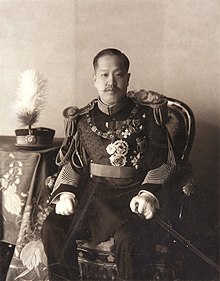Loading AI tools
Last emperor of Korea from 1907 to 1910 From Wikipedia, the free encyclopedia
Sunjong (Korean: 순종; Hanja: 純宗; 25 March 1874 – 24 April 1926),[1][2] personal name Yi Cheok (이척; 李坧), also known as the Yunghui Emperor (융희제; 隆熙帝), was the last Korean monarch. He ruled from 1907 to 1910 as the second and last emperor of the Korean Empire. Sunjong was elevated to the throne after his predecessor and father, Gojong, was forced to abdicate by the Empire of Japan. Hence, Sunjong has been characterized by historians as being a powerless puppet ruler of the Japanese, reigning for just three years before Korea was officially annexed in 1910.
| Sunjong of Korea 대한제국 순종 大韓帝國純宗 | |||||||||||||||||
|---|---|---|---|---|---|---|---|---|---|---|---|---|---|---|---|---|---|
 Sunjong wearing Court uniform and dress of the Korean Empire c. 1910 | |||||||||||||||||
| Emperor of Korea | |||||||||||||||||
| Reign | 19 July 1907 – 29 August 1910 | ||||||||||||||||
| Predecessor | Gojong of Korea | ||||||||||||||||
| Successor | Monarchy abolished (Korea annexed by Japan) | ||||||||||||||||
| Born | 25 March 1874 Changdeok Palace, Hanseong, Joseon | ||||||||||||||||
| Died | 24 April 1926 (aged 52) Changdeok Palace, Keijō, Keiki Province, Chōsen, Empire of Japan | ||||||||||||||||
| Burial | |||||||||||||||||
| Spouse | |||||||||||||||||
| |||||||||||||||||
| Clan | Jeonju Yi | ||||||||||||||||
| Dynasty | Yi | ||||||||||||||||
| Father | Gojong of Korea | ||||||||||||||||
| Mother | Empress Myeongseong | ||||||||||||||||
| Religion | Korean Confucianism (Neo-Confucianism) | ||||||||||||||||
| Korean name | |
| Hangul | 순종 융희제 |
|---|---|
| Hanja | |
| Revised Romanization | Sunjong Yunghuije |
| McCune–Reischauer | Sunjong Yunghije |
| Art name | |
| Hangul | 정헌 |
| Hanja | |
| Revised Romanization | Jeongheon |
| McCune–Reischauer | Chŏnghŏn |
| Birth name | |
| Hangul | 이척 |
| Hanja | |
| Revised Romanization | I Cheok |
| McCune–Reischauer | Yi Ch'ŏk |
| Courtesy name | |
| Hangul | 군방 |
| Hanja | |
| Revised Romanization | Gunbang |
| McCune–Reischauer | Kunbang |
Sunjong was the second son of Emperor Gojong and Empress Myeongseong. When he turned two years old in 1876, Sunjong was proclaimed the Crown Prince of Joseon. In 1882, he married a woman of the Yeoheung Min clan (later Empress Sunmyeonghyo). She died at the age of 31 on 5 November 1904 due to a severe depression, after trying to protect her mother-in-law (Empress Myeongseong, also a member of the Yeoheung Min clan) from her assassination on 8 October 1895 by the Japanese military.
When his father proclaimed Korea as an Empire in 1897, Sunjong was appointed as the Crown Prince of Imperial Korea on 12 October 1897.[3] On 29 June 1898, he was appointed as the Field Marshal of the Imperial Korean Army.[4] Sunjong remarried again 3 years later to the daughter of Yoon Taek-young, Yun Jeung-sun of the Haepyeong Yun clan, who was 20 years younger than him, on 11 December 1906,[5] and she became Crown Princess Consort Yun (later Empress Sunjeong).
On 19 July 1907, Gojong was deposed as a result of Japanese coercion, and Sunjong was made the Emperor of Korea. His coronation was proceeded in Don-doek-jeon.[6] He was proclaimed heir to the throne of Prince Imperial Yeong, the younger half-brother of Sunjong, and moved from Deoksugung Palace to the imperial residence at Changdeokgung Palace.[7]
Sunjong's reign was limited by the gradually increasing armed intervention of the Japanese government in Korea. In July 1907, he was proclaimed emperor of Korea but was immediately forced to enter into the Japan–Korea Treaty of 1907. This treaty allowed the Japanese government to supervise and intervene in the administration and governance of Korea, which also allowed for the appointment of Japanese ministers within the government.[8]
While under Japanese supervision, the Korean army was dismissed on the pretext of a lack of public finance regulations. In 1909, Japan implemented the Japan–Korea Protocol, which effectively removed Korea's judicial power. Meanwhile, Japan dispatched Itō Hirobumi, Japanese Resident-General of Korea, to negotiate with Russia over problems involving Korea and Manchuria. However, Itō was assassinated by Ahn Jung-geun at Harbin, which led to the Japanese annexation of Korea in 1910. Pro-Japanese politicians, such as Song Byung-jun and Lee Wan-yong, defected, merging Korea with Japan by fabricating Korea's willingness and establishing the Japan–Korea Annexation Treaty on 29 August 1910.[9][10]
Although still existent de jure, the intervention by the Japanese government effectively ended Sunjong's reign over the Korean Empire de facto and he became essentially powerless within three years of ruling. Japan, in effect, officially abolished the Korean Empire on 29 August 1910, ending 519 years of the Joseon dynasty.[11]

After the annexation treaty, the former Emperor Sunjong and his wife, Empress Sunjeong, lived the rest of their lives virtually imprisoned in Changdeokgung Palace (in present-day Seoul).[12] Sunjong could not exercise any power as emperor because there were only pro-Japanese politicians in the government. After the Korean Empire collapsed, Sunjong was demoted from emperor to king. Japan allowed him the title of King Yi of Changdeok Palace (창덕궁 이왕; 昌德宮 李王) and allowed for the title to be inherited.[7]
Sunjong died on 24 April 1926, in Changdeokgung and is buried with his two wives at the imperial tomb of Yureung (유릉; 裕陵) in the city of Namyangju. His state funeral on 10 June 1926, was a catalyst for the June 10th Movement against Japanese rule. He had no children.[13]
Consort(s) and their respective issue
| Ancestors of Sunjong of Korea | |||||||||||||||||||||||||||||||||||||||||||||||||||||||||||||||||||||||||||||||||||||||||||||||||||||||||||||||||||||||||||||||||||||||||||||||||||||||||||||||||||||||||||||||||||||||||||||||||||||||||||||||||||||||||||||||||||||||||||||||||||||||||||||||||||||||||
|---|---|---|---|---|---|---|---|---|---|---|---|---|---|---|---|---|---|---|---|---|---|---|---|---|---|---|---|---|---|---|---|---|---|---|---|---|---|---|---|---|---|---|---|---|---|---|---|---|---|---|---|---|---|---|---|---|---|---|---|---|---|---|---|---|---|---|---|---|---|---|---|---|---|---|---|---|---|---|---|---|---|---|---|---|---|---|---|---|---|---|---|---|---|---|---|---|---|---|---|---|---|---|---|---|---|---|---|---|---|---|---|---|---|---|---|---|---|---|---|---|---|---|---|---|---|---|---|---|---|---|---|---|---|---|---|---|---|---|---|---|---|---|---|---|---|---|---|---|---|---|---|---|---|---|---|---|---|---|---|---|---|---|---|---|---|---|---|---|---|---|---|---|---|---|---|---|---|---|---|---|---|---|---|---|---|---|---|---|---|---|---|---|---|---|---|---|---|---|---|---|---|---|---|---|---|---|---|---|---|---|---|---|---|---|---|---|---|---|---|---|---|---|---|---|---|---|---|---|---|---|---|---|---|---|---|---|---|---|---|---|---|---|---|---|---|---|---|---|---|---|---|---|---|---|---|---|---|---|---|---|---|---|---|---|---|
| |||||||||||||||||||||||||||||||||||||||||||||||||||||||||||||||||||||||||||||||||||||||||||||||||||||||||||||||||||||||||||||||||||||||||||||||||||||||||||||||||||||||||||||||||||||||||||||||||||||||||||||||||||||||||||||||||||||||||||||||||||||||||||||||||||||||||
Seamless Wikipedia browsing. On steroids.
Every time you click a link to Wikipedia, Wiktionary or Wikiquote in your browser's search results, it will show the modern Wikiwand interface.
Wikiwand extension is a five stars, simple, with minimum permission required to keep your browsing private, safe and transparent.